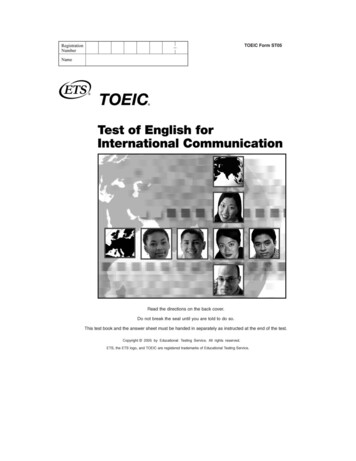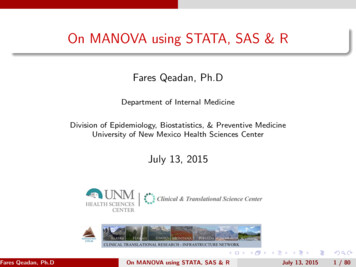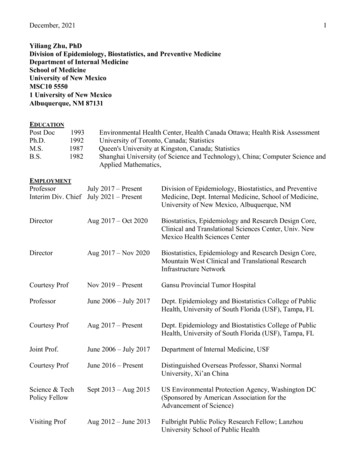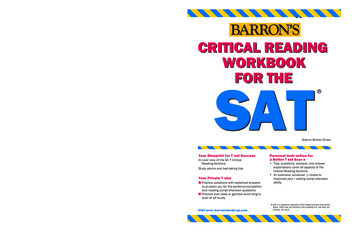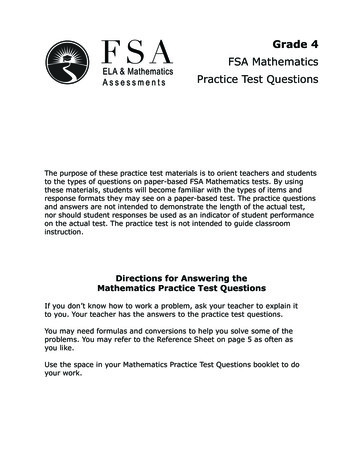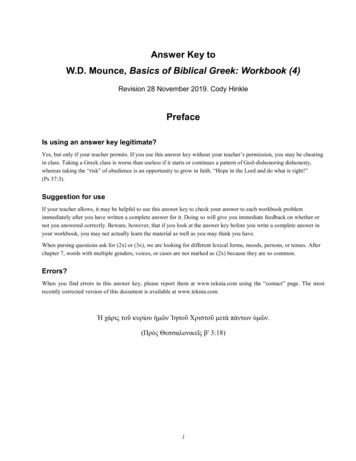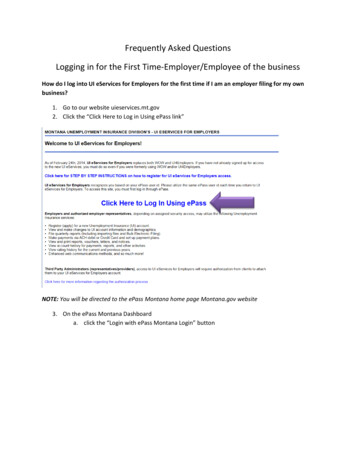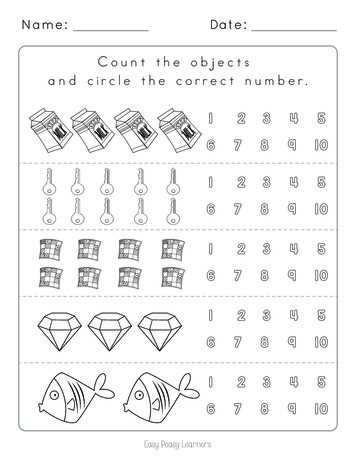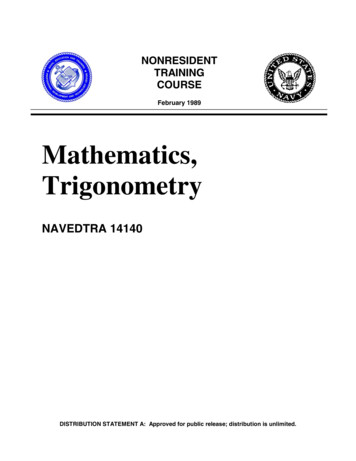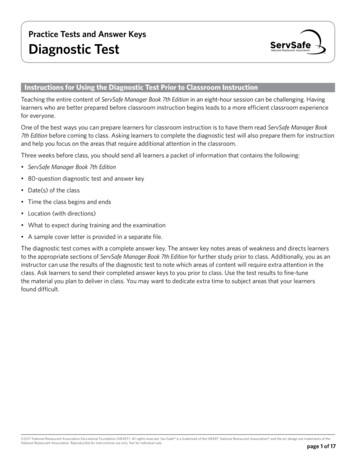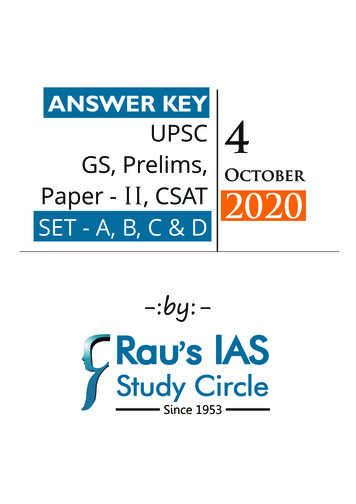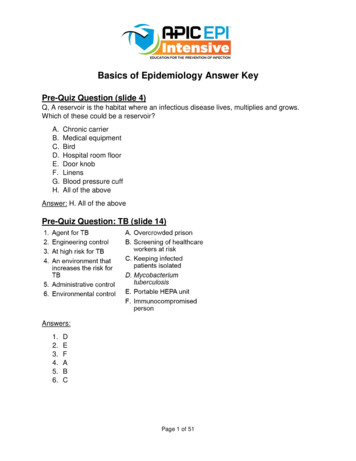
Transcription
Basics of Epidemiology Answer KeyPre-Quiz Question (slide 4)Q, A reservoir is the habitat where an infectious disease lives, multiplies and grows.Which of these could be a reservoir?A.B.C.D.E.F.G.H.Chronic carrierMedical equipmentBirdHospital room floorDoor knobLinensBlood pressure cuffAll of the aboveAnswer: H. All of the abovePre-Quiz Question: TB (slide 14)Answers:1.2.3.4.5.6.DEFABCPage 1 of 51
Pre-Quiz Questions (slide 34)Q. What precautions do we use with every patient?Answer: Standard PrecautionsQ. What precautions do we use with patients with possible TB?Answer: Airborne PrecautionsQ. What precautions do we use with a patient with profuse diarrhea?Answer: Contact PrecautionsQ. What precautions do we use with a patient that may have whooping cough?Answer: Droplet PrecautionsScenario (slide 55)When doing rounds on patient care unit, you observed several healthcare personnelfailing to use PPE when caring for a patient/resident on Contact Precautions. What couldyou do to improve PPE practices for isolation precautions?Answer: Pull the staff aside individually and use this “teachable moment” to discussproper PPE use and why this is so importantIdentify personnel on the unit who can assist in improving practices(administrator, physical or other champion, direct care personnel, others ); forma teamSend the CDC and other related guidelines for preventing transmission ofinfections to these personnelCollaborate with unit personnel to identify barriers to proper PPE use; how PPEuse can be improved; availability of PPE, etc.Reeducate the staffObserve and/or audit on rounds at later time for improvementPage 2 of 51
Infection Preventionist as an Educator Answer KeyQuiz Matching Question (slide 20)Answers: Assess Needs – Identify what topics need to be taught Lesson Plan - Create a step by step plan Determine teaching method – Formal lecture or 1:1 Preparation – Objectives, materials, location and timing is establish at this step Evaluation – Determine success of the educationPage 3 of 51
Life as a Detective and NHSN Basics Answer KeyPre-Quiz Question (slide 2)Q. The most essential component of an effective Infection Prevention surveillanceprogram is:A. The capability to monitor everythingB. Collection of meaningful dataC. Outbreak detectionD. Complying with accreditation agenciesAnswer: B. Collection of meaningful data.Your Infection Prevention surveillance program is only as good as your data.Scenario 1 (slide 4)Q. Which of the following you would include in your presentation:Answer: E. All of the abovePage 4 of 51
Pre-Quiz Definitions (slide 15)Match the term on the right with a definition on the left.Answers: Indicators – D Process – A Outcome – F Risk adjusted – E Infection rate – B Case – D Cluster – GQuick Quiz (slide 23)Q. Identify each item as either a process or an outcome:1. Patient falls2. Hand hygiene compliance3. Maintaining barriers during construction4. difficile infectionAnswers:1. Outcome2. Process3. Process4. OutcomePage 5 of 51
Quick Quiz (slide 35)Q. Label Each As Either Passive Or Active Surveillance1. MRSA screening2. Reportable disease reports3. Laboratory reports4. Hand hygiene compliance5. Prevention standards observations6. Blood-borne pathogen reportsAnswers:1. Active2. Passive3. Passive4. Active5. Active6. PassivePre-Quiz Question #1 (slide 62)Q. What types of facilities can report to NHSN?A. Acute Care Hospitals/FacilitiesB. Inpatient Rehabilitation FacilitiesC. Ambulatory Surgery CentersD. Outpatient Dialysis FacilitiesE. All of the aboveAnswer: E. All of the aboveIn addition to all of the facility types listed on this slide, Long Term Acute Care (LTAC)and Long Term Care (LTC) facilities can also report to NHSN.Page 6 of 51
Pre-Quiz Question #2 (slide 63)Q. The NHSN Infection Window Period is defined as the 5-days during which all sitespecific infection criteria must be met. It includes the day the first positive diagnostic testthat is used as an element of the site-specific infection criterion was obtained, the twocalendar days before and the two calendar days after.A. TrueB. FalseAnswer: B. FalseThe NHSN Infection Window Period is defined as the 7-days during which all sitespecific infection criteria must be met. It includes the day the first positive diagnostic testthat is used as an element of the site-specific infection criterion was obtained, the 3calendar days before and the 3 calendar days after.Quiz – Alphabet Soup (slide 104)Take a moment to identify and explain each of the following based on what you havelearned so far IWP – Is the Infection Window Period. It’s the 7-days during which all site-specificinfection criteria must be met.DOE – is the Date of Event It’s date the first element used to meet a sitespecific infection criterion occurs for the first time within the IWPHAI – is a Healthcare-Associated Infection of course: DOE occurs on or after the3rd calendar day of admission to an inpatient locationSBAP – You just learned about that one That’s the Secondary BloodstreamAttribution Period The period in which a blood specimen must be collected for asecondary bloodstream infection to be attributed to a primary site infection.POA – POA is present on admission DOE occurs the day of admission, 2 daysprior to admission, or the day after admission to an inpatient locationRIT – is the Repeat Infection Timeframe the 14-day timeframe during which nonew infections of the same type are reported.Page 7 of 51
Recap Quiz! Question 1 (slide 118)Q, It’s ok to allow my Infectious Disease physician to overrule my NHSN HAIdeterminations as long as he has clinical documentation to support his decision.A. TrueB. FalseAnswer: B. FalseIt is NEVER ok to allow anyone, no matter their role in your organization, to change yourHAI determination unless they are better able to apply NHSN definitions to your case.Recap Quiz! Question 2 (slide 119)Q. Which of the following is a 14-day timeframe during which no new infections of thesame type are reported?A. IWPB. RITC. SBAPD. LOAAnswer: B. RITRecap Quiz! Question 3 (slide 120)Q. Additional pathogens recovered during the RIT from the same type of infection areadded to the eventA. TrueB. FalseAnswer: A. TrueRecap Quiz! Question 4 (slide 121)Q. If a patient has positive urine culture on admission with 100,000 CFU/ml E. coli and thepatient states they felt like they had a fever the night before, you can use this to determine thepatient has a SUTI on admission.A. TrueB. FalseAnswer: B. FalseThe patient must report their actual temperature, such as 100.6, and it be documentedin the medical record. It is not sufficient for the patient to only say they had a fever.Page 8 of 51
Recap Quiz! Question 5 (slide 122)Q. Which of the following is/are considered a diagnostic test and can be used to set aninfection window period?A. Laboratory specimen collectionB. Imaging TestC. Procedure or ExamD. All of the aboveAnswer: D. All of the abovePage 9 of 51
CAUTI Answer KeyPre-Quiz Questions (slide 3)Q. For NHSN CAUTI surveillance, the collection date of the positive urine culture alwayssets the Infection Window Period.A. TrueB. FalseAnswer: A. TrueThe collection date of a positive urine culture always sets the Infection Window Period,provided it meets the NHSN criteria of having no more than 2 species of organisms, oneof which is a bacteria 105 CFU/ml. Pay close attention to the dates on the lab reportsand don’t confuse the report date with the collection date.Case Scenario 1 (slide 27)Page 10 of 51
Case Scenario 1 – Question 1 (slide 28)Q. Does this patient have an HAI?A. YesB. NoAnswer: A. YesThis patient has an HAI because the Date of Event occurred on the 4th calendar day ofadmission to an inpatient location.Case Scenario 1 – Question 2 (slide 29)Q. Does this patient have a CAUTI?A. Yes, SUTI 1aB. NoC. Yes, ABUTID. Yes, SUTI 2Answer: A. Yes, the patient has a SUTI 1A.The patient has a foley 2 calendar days on the date of event, suprapubic tendernesswith no other recognized cause, and a urine culture with no more than two species oforganisms, at least one of which is a bacterium growing 100,000 cfu/ml.Page 11 of 51
Case Scenario 2 (slide 31)Case Scenario 1 – Question 1 (slide 32)Q. Does this patient have a CAUTI?A. Yes, SUTI 1aB. Yes, SUTI 1bC. NoD. Yes, ABUTIAnswer: D, Yes ABUTI.The patient has a foley 2 calendar days, no s/s of UTI during the IWP and a positiveblood culture that matches an organism in the urine that is growing 100,000 cfu/ml.Page 12 of 51
Case Scenario 2 – Question 2 (slide 33)Q. What is the Date of Event?A. 6/2B. 5/31C. 6/3D. 6/6Answer: C, 6/3The date the first element used to meet an NHSN site-specific infection criterion (in thiscase the positive blood culture) occurs for the first time within the seven-day infectionwindow period. Remember, if you have a positive blood culture, you should continue tomonitor for additional positive cultures throughout the Infection Window Period andsecondary attribution period. Do not assume that the patient has a primary BSI becausethe first positive culture is a positive blood.Case Scenario 3 (slide 35) 4/10 - 75 year old female admitted to ICU with possible sepsis; urine culture onadmission is positive for 100,000 cfu/ml E. coli, blood cultures x2 are negative;patient has no signs or symptoms of a UTI. 4/11 - Patient has temp of 100.8; no dysuria, frequency, urgency, CVA pain, orsuprapubic tenderness 4/12 – Temp of 100.2; foley placed 4/15 – Urine culture positive for 100,000 cfu/ml E. coli 4/17 – Temp of 101.0Case Scenario 3 – Question 1 (slide 36)Q. Does this patient have a UTI Present on Admission (POA)?A. Yes, SUTI 1aB. NoC. Yes, SUTI 1bD. Yes, ABUTIAnswer: B, No.Although the patient has a fever and positive urine culture during the first 2 days ofadmission (in the POA period), this patient does not have a NHSN UTI because fevercannot be used as a UTI criterion in a patient 65 years of age when a foley is not inplace.Page 13 of 51
Case Scenario 3 – Question 2 (slide 37)Q. Since this patient did not have a UTI Present on Admission, do they have a CAUTIresulting from the second positive urine culture? If so, what is the Date of Event?A. Yes, they have a SUTI 1a with DOE of 4/15B. No, they do not have a CAUTI since the urine culture on 4/15 grew the sameorganism as the urine culture Present on AdmissionC. Yes, they have a SUTI 1a with a DOE of 4/17D. Yes, they have a SUTI 1b with a DOE of 4/15Answer: A, Yes, they have a SUTI 1a with DOE of 4/15The patient did not meet NHSN UTI criteria in the POA period, therefore a foley in place 2 calendar days, a positive urine culture with 100,000 cfu/ml E. coli on 4/15, andfever on 4/17 meet NHSN SUTI 1a criteria.The Date of Event is 4/15 since that is the date the first element used to meet an NHSNsite-specific infection criterion (in this case the positive urine culture) occurs for the firsttime within the seven-day infection window period.Case Scenario 4 (slide 39)Page 14 of 51
Case Scenario 4 – Question 1 (slide 40)Q. Does the patient have a UTI on 9/22?A. Yes, SUTI 1aB. NoC. Yes, ABUTID. Yes, SUTI 1bAnswer: D, Yes, SUTI 1bThe patient has a temp 38C and a positive urine growing 100,000 cfu/ml of abacteria, but does not have a foley for 2 calendar days, so it’s a SUTI 1b.Case Scenario 4 – Question 2 (slide 41)Q. Does the patient have a reportable CAUTI on 9/30?A. Yes, another SUTI 1aB. NoC. Yes, ABUTID. Yes, SUTI 1bAnswer: B, NoThis patient has a second SUTI on 9/30, in the Repeat Infection Timeframe of the 9/22SUTI. You do not change the device association during a Repeat Infection Timeframe.Even though the patient had a foley 2 calendar days at the time of the 9/30 SUTI, youwould not change the 9/22 non-catheter associated SUTI to a catheter-associated.Case Scenario 4 – Question 3 (slide 42)Q. If the non-catheter associated UTI from 9/22 was reported to NHSN, whatorganism(s) would be reported?A. E. coliB. Klebsiella pneumoniaeC. E. coli and Klebsiella pneumoniaeAnswer: C, E. coli and Klebsiella pneumoniaeIf the non-catheter associated UTI on 9/22 were reported to NHSN, the Klebsiellapneumoniae from the 9/30 SUTI would be reported along with the E. coli from the 9/22SUTI since the 9/30 SUTI fell into the 14-day Repeat Infection Timeframe of the 9/22SUTI.If you only report CAUTI to NHSN, this case would not be reported.Page 15 of 51
Case Scenario 5 (slide 44)Case Scenario 5 – Question 1 (slide 45)Q. Does this patient have a CAUTI? If so, what is the Date of Event?A. Yes, SUTI 1a with DOE of 7/15B. NoC. Yes, SUTI 1a with DOE of 7/12D. Yes, ABUTI with DOE of 7/15Answer: C. Yes, SUTI 1a with DOE of 7/12The positive urine culture on 7/15 sets an Infection Window Period of 7/12-7/18. Thedysuria occurs on 7/12 and that is the first symptom of the UTI within the InfectionWindow Period.Did you notice the positive urine culture occurred 4 days after the foley was removed?When reviewing positive urine cultures, don’t assume you don’t have a CAUTI becausethere was no foley in place the day before the urine culture was collected. You need tolook back 4 days from the date of the urine culture to ensure you have no symptoms ofa UTI or foley in place.Page 16 of 51
Case Scenario 5 – Question 2 (slide 46)Q. What organism(s) is/are reported for the CAUTI?A. Pseudomonas aeruginosaB. Candida albicansC. Pseudomonas aeruginosa and Candida albicansAnswer: A Pseudomonas aeruginosa.Candida is an excluded organism for CAUTI, so only Pseudomonas is reported.Case Scenario 5 – Question 3 (slide 47)Q. What is the Location of Attribution for the CAUTI?A. ICUB. Med/surg unitAnswer: A. ICUPer the Transfer Rule: If the date of the event is the day of transfer/discharge or the dayafter, the infection is attributed to the transferring location. In this case, the DOE is 7/12and the patient was transferred from ICU to med/surg unit on the day before. Since theICU was the transferring unit on 7/11, that is the Location of Attribution.Page 17 of 51
CLABSI Case Scenarios Answer KeyApplying BSI DefinitionsCase Scenario 5 (slide 42)Case Scenario 1 – Question 1 (slide 43)Q. Does this patient have a HAI? If so, what is the Date of Event?A. Yes, with DOE of 12/7B. NoC. Yes, with DOE of 12/5Answer: A. Yes, with DOE of 12/7This patient has a HAI. The date of event is 12/7 and after the 3 rd calendar day ofadmission.Case Scenario 1 – Question 2 (slide 44)Q. Does this patient have a CLABSI?A. YesB. NoAnswer: A. YesThis is a CLABSI. Patient has a CL in place 2 calendar days and a recognizedpathogen identified from 1 or more blood cultures and the organism is not related to aninfection at another site.Page 18 of 51
Case Scenario 2 (slide 46)Case Scenario 2 – Question 1 (slide 47)Q. Does this patient have a CLABSI?A. NoB. Yes, LCBI 1C. Yes, LCBI 3D. Yes, LCBI 2Answer: D. Yes, LCBI 2Patient has a CL 2 calendar days, a fever and a common commensal is identified fromtwo blood specimens drawn on separate occasions and consecutive calendar days andorganisms are not related to an infection at another site.Staph epidermidis and Coagulase negative Staph are considered matching organismsbecause Staph epidermidis is a Coagulase negative Staph.Page 19 of 51
Case Scenario 2 – Question 2 (slide 48)Q. What is the date of first diagnostic test?A. 1/16B. 1/14C. 1/17Answer: A. 1/16The matching common commensals represent a single criteria, therefore the date of theFIRST common commensal is the date of the first diagnostic testCase Scenario 3 (slide 50)Case Scenario 3 – Question 1 (slide 51)Q. Does this patient have a HAI?A. Yes, patient has a CLABSI with a DOE of 7/16B. No, patient has a BSI Present on Admission with a DOE of 7/14C. No, patient does not have any type of infectionD. Yes, patient has a BSI with a DOE of 7/14Answer: B. No, patient has a BSI Present on Admission with a DOE of 7/14The patient does have a BSI and it is present on admission with a DOE of 7/14; the firstsign of infection is bradycardia occurring on the day after admission to an inpatientlocation. This is within the POA period, therefore the patient does not have HAI.Page 20 of 51
Case Scenario 3 – Question 2 (slide 52)Q. What type of BSI does this patient have?A. LCBI 2B. LCBI 1C. LCBI 3Answer: C. LCBI 3Patient has a LCBI 3, they have apnea, bradycardia, the same common commensal isidentified from two or more blood specimens drawn on separate occasions, andorganism identified is not related to an infection at another siteCase Scenario 4 (slide 54)Page 21 of 51
Case Scenario 4 – Question 1 (slide 55)Q. Does this patient have a CLABSI?A. Yes, one LCBI 1 with DOE of 8/25B. NoC. Yes, LCBI 1 with DOE of 8/18 and a second LCBI 1 on 8/25 in the RITD. Yes, one LCBI with a DOE of 8/18Answer: C. Yes, LCBI 1 with DOE of 8/18 and a second LCBI 1 on 8/25 in the RITPatient has a CL 2 calendar days, positive blood cultures on 8/18 with a recognizedpathogen and no other source of infection is identified. On 8/25 the patient again has arecognized pathogen with no other source identified. The LCBI on 8/25 falls into the 14day RIT of the 8/18 LCBI.Case Scenario 4 – Question 2 (slide 56)Q. What BSI organisms are reported?A. E. coliB. Staph aureusC. E. coli and Staph aureusAnswer: C. E. coli and Staph aureusThe pathogen from the 8/18 CLABSI is reported and the pathogen from the 8/25 BSI isalso reported on the 8/18 CLABSI since it falls within the 14-day RIT of that HAI.Case Scenario 4 – Question 3 (slide 57)Q. What is the Location of Attribution (LOA) for the 8/18 CLABSI?A. Med/SurgB. TelemetryAnswer: A. Med/Surg.Per the Transfer Rule: If the date of the event is the day of transfer/discharge or the dayafter, the infection is attributed to the transferring location. In this case, the DOE is 8/18and the patient was transferred from Med/Surg to Telemetry on the day before.Since the med/surg unit was the transferring unit on 8/17, that is the Location ofAttribution.Page 22 of 51
Case Scenario 5 (slide 59)Case Scenario 5 – Question 1 (slide 60)Q. What day does the CL count begin?A. 5/12B. 5/13C. 5/14Answer: C. 5/14The device day count begins on 5/12 for the purpose of denominator CL day count, butit begins on 5/14 for the purpose of determining device attribution since that is the firstday the line is accessed on an inpatient unit. This line will continue to be counted until itis discontinued or the day after patient discharge.Case Scenario 5 – Question 2 (slide 61)Q. What type of CLABSI does this patient have?A. LCBI 1B. MBI-LCBI-1C. The patient does not have CLABSID. MBI-LCBI-2Answer: B. MBI-LCBI-1Patient has a CL 2 calendar days, at least on blood specimen with an intestinalorganism from the MBI organism list and 2 separate days of ANC or total WBC 500cells/mm3 within a 7 day period [date of positive blood culture, 3 calendar days before,and 3 calendar days after])Page 23 of 51
Case Scenario 5 – Question 3 (slide 62)Q. What is the Date of Event?A. 5/19B. 5/17C. 5/20D. 5/18Answer: A. 5/19For MBI-LCBIs, ANC/WBC levels should not be used to set the IWP or to identify thedate of event. MBI-LCBIs are subsets of LCBIs and therefore the date of the LCBIwould be the date of the MBI-LCBI event.Page 24 of 51
CLABSI Case Scenarios Answer KeySecondary Bloodstream Infection DeterminationCase Scenario 1 (slide 65)Case Scenario 1 – Question 1 (slide 66)Q. What HAI does this patient have?A. BSI secondary to CAUTIB. UTI secondary to CLABSIC. Only CLABSID. Only CAUTIAnswer: A. BSI secondary to CAUTIThis patient has a BSI secondary to a CAUTI. The patient meets CAUTI criteria with afoley in 2 calendar days, fever, and positive urine culture with 100,000 E coli. Sincethe blood specimen matches an organism identified from the site-specific infection thatis used as an element to meet the NHSN site-specific infection criterion (the urineculture with E. coli) AND the blood specimen is collected during the secondary BSIattribution period, it is a secondary BSI.Page 25 of 51
Case Scenario 1 – Question 2 (slide 67)Q. What organism(s) is/are reported to NHSN?A. E. coliB. Staph aureusC. E. coli and Staph aureusAnswer: C. E. coli and Staph aureusPathogens identified from secondary BSIs, should be added to those pathogensreported for the primary infection type. In this example, the E. coli is reported for theCAUTI and the Staph aureus is added as the pathogen for the secondary BSI.Case Scenario 2 (slide 69)Page 26 of 51
Case Scenario 2 – Question 1 (slide 70)Q. What HAI does this patient have?A. CLABSIB. BSI secondary to VAEC. Pneumonia (PNU2) onlyD. BSI secondary to PNU2Answer: D. BSI secondary to PNU2.The patient has a PNU2 with 2 serial CXR showing new and persistent infiltrates, atemp 100.4, tachypnea, and organisms identified from the blood in the IWP. Becausethe organism in the blood specimen is an element used to meet the NHSN PNU2infection and is collected within the PNU2 IWP, the BSI is secondary to the PNU2.Case Scenario 2 – Question 2 (slide 71)Q. What is the first diagnostic test or sign/symptom that sets the Infection WindowPeriod?A. TachypneaB. First Chest x-rayC. Positive blood cultureD. TemperatureAnswer: B. First Chest x-rayThe first imaging test (or chest x-ray) is the first diagnostic test setting the IWP for thePNU2.Case Scenario 2 – Question 3 (slide 72)Q. If the blood culture grew Enterococcus faecalis, would this still be a PNU2 withsecondary BSI?A. YesB. NoAnswer: B. No.Enterococcus faecalis is an excluded organism from PNEU/VAP definition unless it isidentified from lung tissue or pleural fluid, so a blood culture growing Enterococcusfaecalis cannot be a secondary BSI to a PNEU/VAP. If there were no other sources ofinfection, the blood culture with Enterococcus would be a CLABSI.Page 27 of 51
Case Scenario 3 (slide 74)Case Scenario 3 – Question 1 (slide 75)Q. Does this patient have a secondary BSI? If so what site-specific infection is itsecondary to?A. Yes, GITB. No, patient does not have a secondary BSIC. Yes, IABD. Yes, OREPAnswer: C. Yes, IAB - see following slide 72 for additional detailsThe IAB 3b site-specific criteria is met with nausea and vomiting with no otherrecognized cause, fever, positive blood culture with a MBI organism and imagingevidence of an infection. The secondary BSI criteria is met because an organismidentified in the blood specimen is an element that is used to meet the NHSN sitespecific infection criterion, and is collected during the site-specific infection windowperiod.Page 28 of 51
Case Scenario 3 – Question 2 (slide 77)Q. Could this abdominal abscess be an organ space surgical site infection attributed tothe patient’s gallbladder surgery on 11/5?A. YesB. NoAnswer: B. NoThis cannot be a SSI because the surveillance period for cholecystectomy (CHOL) is 30days and the signs and symptoms of the IAB began after the surveillance period.Page 29 of 51
Risk Assessment Answer KeyPre-Quiz Question (slide 3)Q. The purpose of the risk assessment is to act as a guide and focus for your annualinfection control plan.A. TrueB. FalseAnswer: A. TrueScenario 1: High Level Disinfection (slide 5)Q. When reviewing microbiology cultures you notice that there is a cluster ofEnterobacter cloace infections. Upon further review you find that all of the affectedpatients had a recent endoscopy in your gastroenterology procedure area. You performan assessment of the area and find a breach in high level (HLD) disinfection practices.A risk assessment should be completed evaluating HLD practices?A. TrueB. FalseAnswer: A. TrueScenario 1 (slide 6)Q. Once you’ve identified the risk, what are the three main components that need to beevaluated to conduct the risk assessment?A. The probability of the event occurringB. The names of the individuals responsible for the breachC. The Impact or severity if the event occursD. Your current systems or level of preparedness for the eventE. Hand hygiene compliance rates in the procedural area where the risk wasidentifiedAnswer: A, C, DPage 30 of 51
Scenario 2: CLABSI (slide 7)Q. You have completed a risk assessment for your organization and identified centralline-associated bloodstream infections (CLABSI) as the top priority for your infectionprevention program. The risk assessment team develops a CLABSI rate goal for theorganization. The team then has to develop measurable objectives and strategies tomeet those objectives.You do not need to develop an evaluation method for your objectives at this time?A. TrueB. FalseAnswer: B. FalseScenario 2: CLABSI (slide 7)Q. Which of the following are evidence-based strategies to prevent CLABSI? Select allthat apply:A. Use aseptic technique to insert all central linesB. Use an insertion checklist to improve adherence to best practicesC. Health care personnel must ensure that a patient’s CVC is removed or replacedat the appropriate time and in a safe mannerD. Change dressings over the site every seven days for gauze dressings or everytwo days for semipermeable dressingsE. All of the aboveAnswers: A, B, CReference is TJC CLABSI bsi toolkit chapter 3.aspxPage 31 of 51
Pre-Quiz Question: Risk Assessment Team (slide 12)Q. Which of the following services should be part of the risk assessment team?A. Infection Prevention staffB. Environmental ServicesC. PharmacyD. LaboratoryE. NursingF. Central ProcessingG. OtherH. All of the aboveAnswer: H. All of the aboveQuick Quiz (slide 17)Q. The organizational evaluation should be revised based on input from the riskassessment team?A. TrueB. FalseAnswer: A. TrueQuick Quiz (slide 29)Q. Which of the following should be considered when evaluating the probability?A. Loss of functionB. Legal IssueC. Known riskD. Historical dataE. Disruption of servicesF. Reports in literatureG. All of the aboveAnswers: C, D, FPage 32 of 51
Pre-Quiz (slide 40)Q. What are the benefits of using a group to complete the risk assessment?A. Creates a group that is knowledgeable about infection preventionB. Getting buy-in from key stakeholdersC. No single individual will be blamed for prioritiesD. All of the aboveE. None of the aboveAnswer: D. All of the abovePage 33 of 51
MDROs and Other Infectious Diseases of Interest for theInfection Preventionist Answer KeyQuick Quiz Match (slide 34)1. Normally lives in the intestinal tractbut is resistant to VancomycinMRSA2. A gram positive coccus that isresistant to methicillinAntibiotic Stewardship3. Also known as CREEnterococcus4. Prudent use of antibioticsCarbapenem resistantenterobactericaeAnswers:1. Enterococcus2. MRSA3. Carbapenem resistant Enterobacteriaceae4. Antibiotic StewardshipQuick Quiz Match (slide 76)1. Latent TBNegative pressure room2. Airborne InfectionIsolation RoomUsed to prevent inhalation of airborne diseases3. N95/PAPRTuberculin skin test4. TSTInfected with TB, but it’s not activeAnswers:1. Infected with TB, but it’s not active2. Negative pressure room3. Used to prevent inhalation of airborne diseases4. Tuberculin skin testPage 34 of 51
Quick Quiz Match (slide 93)1. Call the local PHDFirst2. Investigate if any patients on the Unit haveHep AFourth3. Confirm the diagnosis – check with Lab, whattest was doneSecond4. Look for any common activities that the threeNurses may haveThirdAnswers:1. Second2. Third3. First4. FourthQuick Quiz Match (slide 95)1. Was this just a chance occurrenceFinger foods are famous fortransmitting bacteria2. The popcorn may have beencontaminated with stool from patientJones.As long as 50 days3. The hand hygiene rate on 5N is 30%.Hep A is transmitted byVery low, 0.4 cases per 100,000population in non-outbreak areas4. Hep A may have a long incubationperiodFecal-oral routeAnswers:1. Very low, 0.4 cases per 100,000 population in non-outbreak areas2. Finger foods are famous for transmitting bacteria3. Fecal-oral route4. As long as 50 daysPage 35 of 51
Activity: What do you think the IP should do? (slide 96)True or False1. Attend the next Unit meeting andeducate the Nurses on how Hep A istransmitted (fecal-oral)2. Cross your fingers and hope that thisnever happens again3. Prohibit potlucks on all Nursing Units4. Share their Unit hand hygiene ratesand ask them how they can improveAnswers:1. True2. False3. True4. TrueQuick Quiz Match (slide 133)1. By 2020 what percentage of HCWsare expected to receive influenzavaccine90%2. What precautions are requires toprevent transmission of influenza?Standard andDroplet3. Adults may be contagious for X daysprior to flu symptomsOne day4. Respiratory etiquette includesCover yourcoughAnswers:1. 90%2. Standard and Droplet3. One day4. Cover your coughPage 36 of 51
Quick Quiz Match (slide 146)1. Disseminated kenpoxtransmitted?Airborne and contact2. How is Shingles contracted?From reactivation ofherpes zoster3. Disseminated Shingles requireswhat precautions?Airborne4. Localized Shingles requires whatprecautions?StandardAnswers:1. Airborne2. From reactivation of herpes zoster3. Airborne and contact4. StandardPage 37 of 51
Surveillance: VAE and LabID Answer KeyWhen Should You Use PNEU/VAP Instead of VAE? (slide 14)A. Never – always use VAEB. When conducting in-plan surveillance on mechanically-ventilated children whoare in pediatric locationsC. When surveillance is conducted for healthcare-associated pneumonia that is notassociated with mechanical ventilationD. When determining if a BSI is secondary to a lower respiratory siteE. B, C, and DAnswer: E. B, C, and D are all appropriate scenarios for using pneumonia/VAP criteria.What Are the Daily Minimum PEEP and FiO2? (slide 30)A. 5 and 0.40B. 8 and 0.60C. 10 and 1.0D. 5 and 0.60Time6 pm7 pm8 pm9 pm10 pm11 pmPeep (cmH2O)1085588FiO21.00.600.400.500.600.60Answer: D. 5 and 0.60A PEEP of 5 and a FiO2 of 0.60 are maintained for 1 hour. You’ll notice that although0.40 was the lowest setting, it was not maintained for 1 hour.Page 38 of 51
Outbreak Investigation ExerciseAnswer KeyDetermine Incidence Ra
Answers: 1. Outcome 2. Process 3. Process 4. Outcome. Page 6 of 51 Quick Quiz (slide 35) Q. Label Each As Either Passive Or Active Surveillance 1. MRSA screening 2. Reportable disease reports 3. Laboratory reports 4. Hand hygiene compliance 5. Prevention standards observations 6. Bloo
